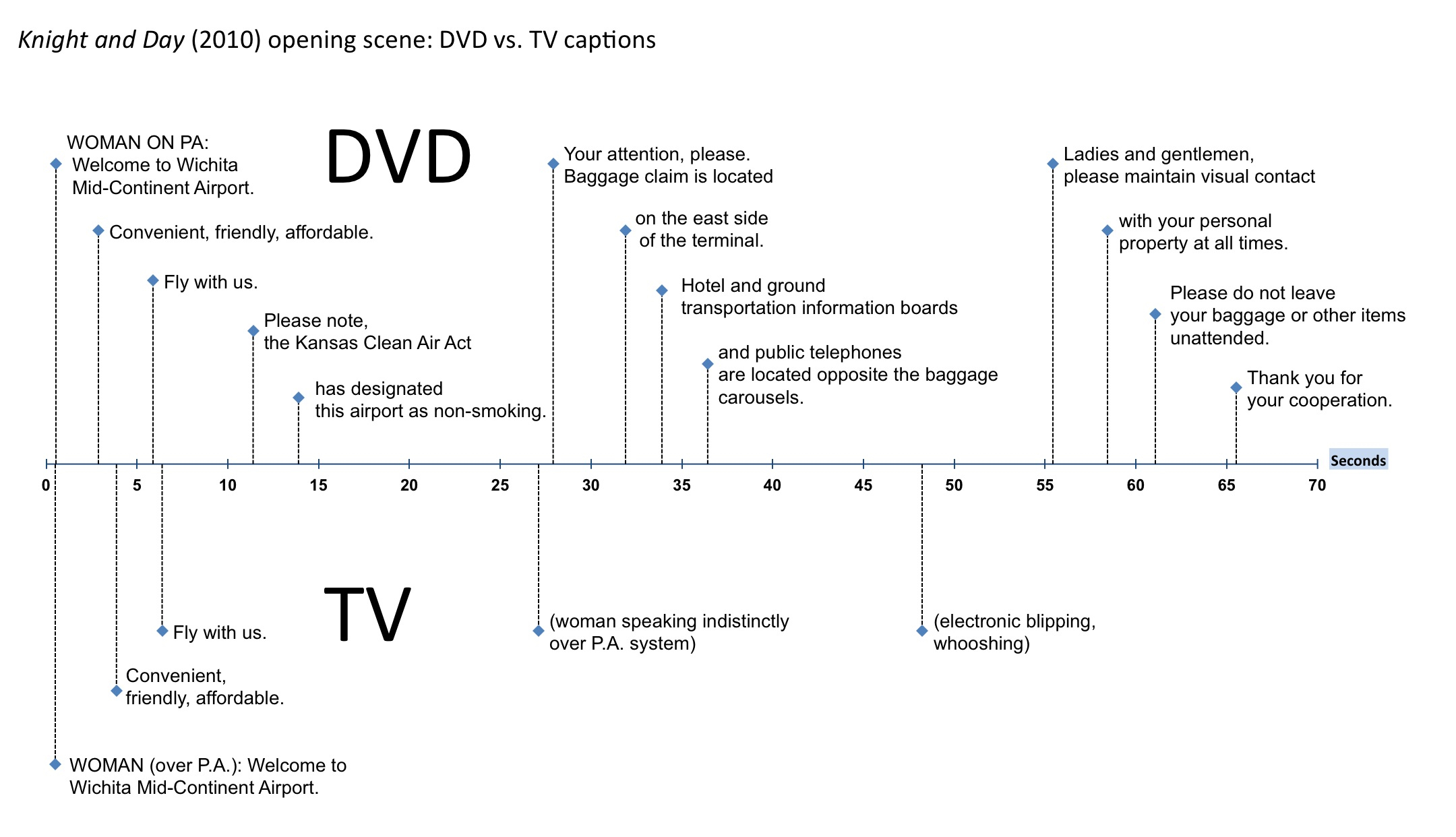This supplemental website includes all of the media clips discussed in Reading Sounds (University of Chicago Press, 2015). Purchase your copy of Reading Sounds today in paperback or e-book.
Figure 4.1. Please maintain visual contact.
A close-up of Roy Miller (Tom Cruise) wearing sunglasses in a frame from Knight and Day. His head fills the entire height of the frame. Caption: “Ladies and gentlemen, please maintain visual contact.” What’s significant and ironic about the accompanying clip is that these words spoken over the airport PA are impossible to make out without captions, regardless of one’s hearing status. In other words, the only way to access these words is to maintain visual contact with the caption track. Twentieth Century Fox, 2010. DVD.
Source: Knight and Day, 2010. DVD. Featured captions include: indistinct speech sounds from the airport PA that are captioned verbatim.
A sampling of subtitle files available on SubScene.com
In this screenshot from SubScene.com, a portion of the subtitle files available for Country Strong are shown. Of the fourteen files available in English, three are marked with an ear icon, which indicates that these files are presumably closed captioned.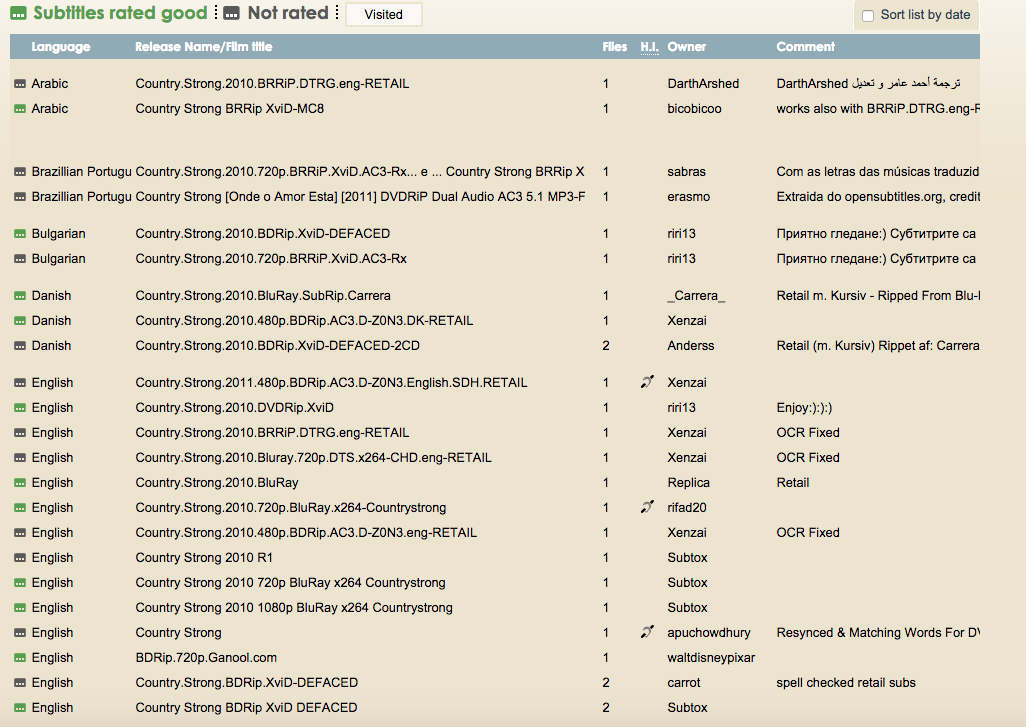
In this screenshot from SubScene.com, a portion of the subtitle files available for Harry Potter and the Deathly Hallows Part 2 are shown. Six files are marked with an ear icon, which indicates that these files are presumably closed captioned. 
Captioning music in Country Strong
While the movie includes some non-speech captions – indeed, the first caption of the movie is (AUDIENCE APPLAUDING) – none of the music lyrics are captioned on the DVD version. Music is identified in the captions by song title such as (BEAU BEGINS SINGING FRIENDS IN LOW PLACES) and, occasionally, by short, unhelpful descriptions such as (SINGS LINE OF A COUNTRY SONG), (RESUMES SINGING), (SINGING), and (MUSIC PLAYING). But lyrics are never captioned in Country Strong, even though the movie is, ironically, about music. The movie reaches the height of irony during the song “Words I Couldn’t Say,” which might as well be referring to the captioned lyrics.
Source: Country Strong, 2010. DVD. Featured captions: (SINGING SUMMER GIRL) and (BEAU BEGINS SINGING FRIENDS IN LOW PLACES). None of the music lyrics are captioned in this movie.
In this compilation of frames from the first forty-three minutes of Country Strong, music titles and unhelpful summaries such as (MUSIC PLAYING) and (SINGING) do not provide sufficient access to the lyrical content of the music.
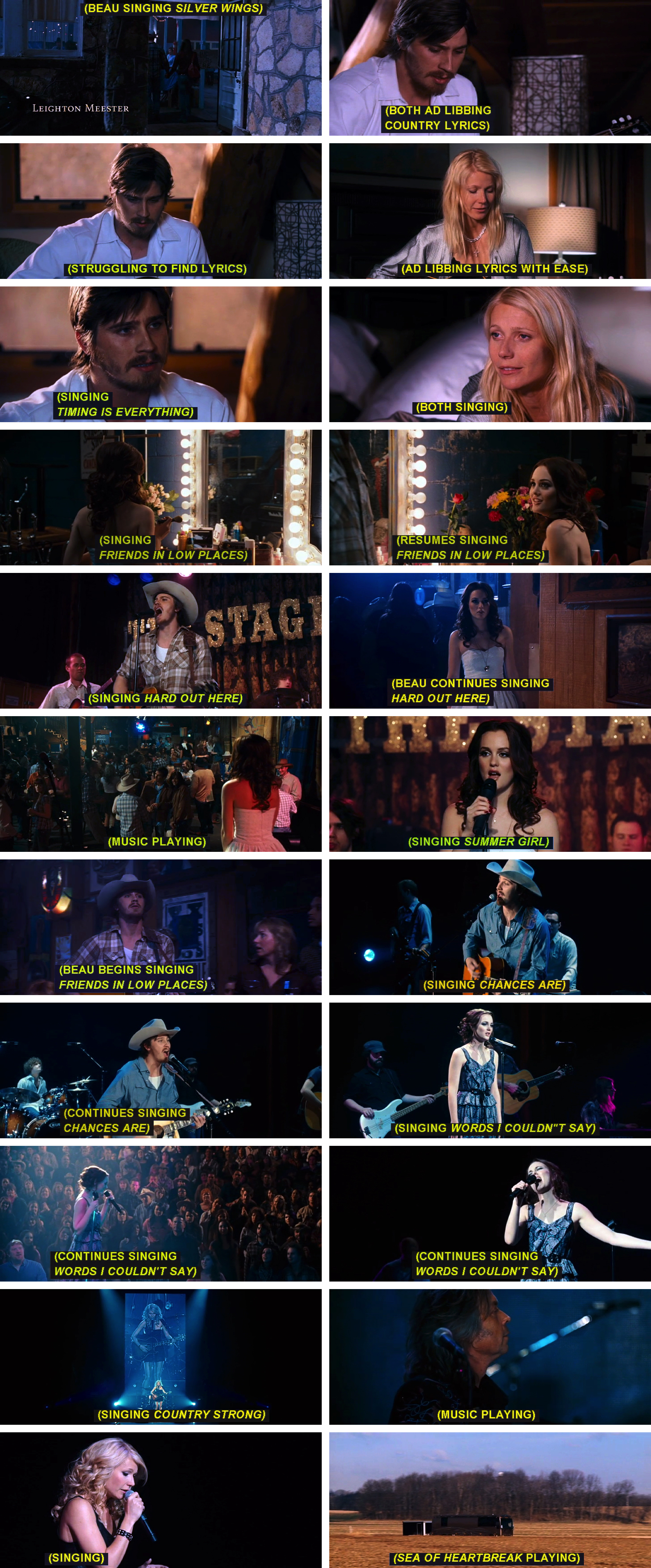
The opening scene of Knight and Day on DVD (uncaptioned)
Source: Knight and Day, 2010. DVD. Uncaptioned version.
Musical phrasing at the end of the opening scene of Knight and Day on DVD
Source: Knight and Day, 2010. DVD. Marked up with Adobe After Effects to emphasize the six musical notes that connect Cruise and Diaz together at the end of the opening scene.
The opening scene of Knight and Day on DVD (captioned)
Source: Knight and Day, 2010. DVD. Featured captions include: indistinct speech sounds from the airport PA that are captioned verbatim.
The opening scene of Knight and Day on broadcast TV
Source: Knight and Day, 2010. Cable TV.
Figure 4.2. A timeline comparing the DVD captions with the TV captions for the opening scene of Knight and Day.
In this figure, the DVD captions have been placed above the timeline. The TV captions have been placed below the timeline. The DVD captions present the PA announcement verbatim, whereas the TV captions attempt to convey something of the ambience of the scene. Neither caption track accounts for the ambient music that provides an emotional register for the scene. Twentieth Century Fox, 2010. This timeline was adapted from a Microsoft Excel template.
In this combined clip, the DVD captions have been inserted into the TV version to allow for some real-time comparisons. The DVD text track has been placed below the TV captions.
Source: Knight and Day, 2010. Cable TV with DVD caption overlay created with Quicktime Pro.
The PA announcement at the end of Taken
Consider the emotional family reunion at the end of Taken, a 2008 thriller starring Liam Neeson. The reunion at the airport following the rescue of Neeson’s daughter from human sex trafficking is disrupted by a captioned, incomplete, and ironic announcement over the airport’s public address system. As the family embraces and speaks to each other in person for the first time since their daughter was kidnapped and sold into sex slavery, a partially muffled PA announcement interjects on the caption layer. A question from the stepfather (“Shall we go?”) interrupts the PA announcement just as the announcer is about to tell viewers and listeners what is “not required.” The main point of the announcement is muffled as the stepfather speaks. It is not possible for hearing viewers to make out the uncaptioned spoken words of the PA. Ironically, the movie itself is about activities that are not officially “sponsored” (i.e., kidnapping, human trafficking). In this sense, then, the PA announcement is relevant to the larger themes of the movie, even if the announcement is most likely not a public warning about kidnapping or slavery. But irony should never be enough to trump a scene’s thematic intensity. Because the announcement disrupts the emotional intensity of the triumphant reunion, and its main idea is inaudible (whose activities are not sponsored?), it should not have been captioned verbatim. A complete, verbatim rendering of the announcement is impossible anyway and only leads to confusion and distraction.
Source: Taken, 2008. DVD. Featured captions include: “[Man on P.A.] Attention travelers, you are not required–” and “This airport does not sponsor their activities.”
The PA announcement in the opening scene of Whiteout
Source: Whiteout, 2009. DVD. Featured captions include expository (as opposed to ambient) PA announcements.
PA as narrative conscience: A compilation of examples from Whiteout
Source: Whiteout, 2009. DVD. A compilation of expository PA announcements from the movie.
The opening scene of Dawn of the Dead
Because Ana is a witness to the terrifying scene, the announcements take on an ironic cast in the opening of Dawn of the Dead. Ana is traveling (PLEASE AVOID TRAVELING…), she is outside (STAY INSIDE AND LOCK ALL DOORS), and she is presumably looking for a safe haven (MILLER PARK IS NO LONGER CONSIDERED A SAFE HAVEN, PLEASE AVOID THE STADIUM AND PROCEED TO OTHER LOCATIONS). In short, because Ana is doing everything she is being told not to do, the announcements effectively add to the sense of terror, even though they all can’t be heard clearly without the aid of verbatim captions.
Source: Dawn of the Dead, 2004. SyFy Channel. Featured captions include expository radio announcements.
The opening scene of World War Z
The announcements are mostly clear and distinct, despite being layered and strung together as a series of interruptions. But as the music swells and the visuals become more disturbing with images of rabid and frenzied animals and insects, the announcements become increasingly difficult to hear clearly as distinct words. Towards the end of the opening scene, (INDISTINCT RADIO CHATTER) initiates a series of captions that can only be heard as ambient noise. Only caption readers have access to the specific meanings contained in these final captions. While the scene is expressly designed to thwart listeners’ attempts to remain calm in the face of growing threats, the captions provide measured and calm transcriptions throughout. Captions clarify meaning, but in doing so they take away some of the rising tension from the scene. That we can no longer make sense of what we’re hearing is conveyed in part through indecipherable announcements and belied by a series of verbatim and seemingly rational captions.
Source: World War Z, 2013. Netflix.
The phone call that sets the plot in motion in Hyde Park on Hudson
We only learn that Daisy (Laura Linney) has been invited to visit the President when she arrives at his mother’s home. No one can hear what the person on the other line is saying. The very low volume of the voice on the other end, in addition to the (DOGS BARKING), prevents Daisy and the hearing audience from hearing the full conversation. That’s the point: Daisy is lost – she says “What?” and “Sinus?” during the call – and so are we. It is thus ironic that the full conversation would be captioned verbatim on the DVD version when the scene is intended to keep the reason for the call a mystery and the conversation can’t be fully discerned anyway without the aid of a production script.
Source: Hyde Park on Hudson, 2012. DVD. Featured caption: “Now I would like you to come over, and I shall expect you this afternoon.” These words are spoken over the phone by the caller. They can’t be heard clearly over the dogs barking but are captioned verbatim.
Randy lectures his family over the sound of the Margaritaville machine on South Park
Source: South Park, “Margaritaville,” 2009. Comedy Central. Uncaptioned version for comparison purposes.
Source: South Park, “Margaritaville,” 2009. Comedy Central. Featured captions include speech sounds that can’t be heard clearly over the whirring blender but are captioned verbatim.
Kenny mumbles on South Park
Source: South Park, “Obama Wins!,” 2012. Comedy Central. Featured captions include speech sounds that are purposely obscured as mumbling but mistakenly captioned verbatim.
Kenny’s muffled speech is captioned in a variety of ways on South Park. The four frames below show a few of the recurring options: ♪ (muffled mumble muffled mumble) ♪ from “The Jeffersons” (Hulu Plus), ♪ (mumbling) ♪ from “ManBearPig,” (DVD), verbatim speech (e.g. “Red Lobster”) from “Obama Wins!” (Cable TV), and “MRPH RMH RMPHM! MRPH RMH!” from “The Tooth Fairy’s Tats 2000” (Cable TV).
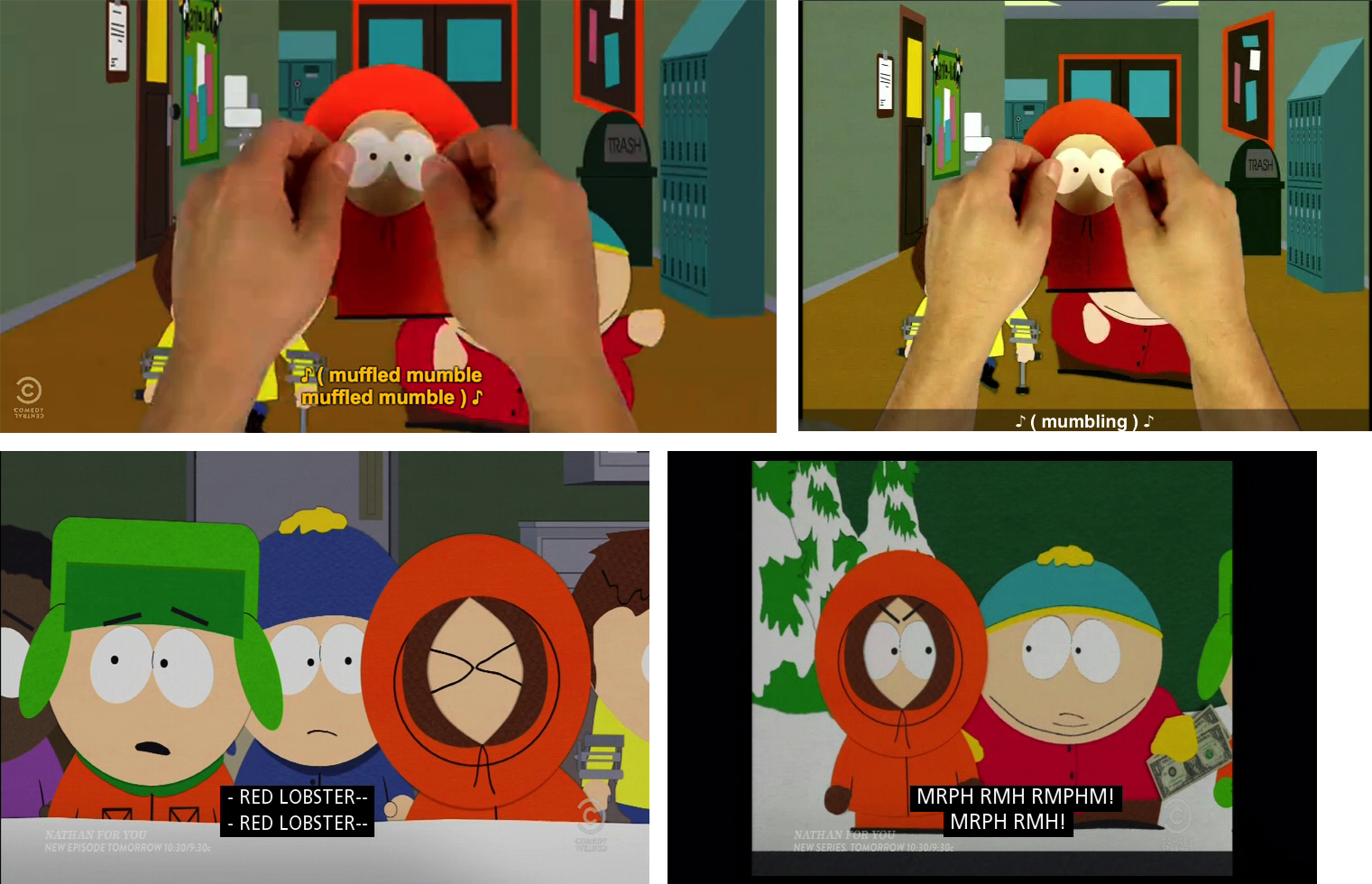
Buster is reenlisted in the Army on Arrested Development (DVD)
Source: Arrested Development, “Forget Me Now,” 2005. DVD. Featured caption: [Rapid Muttering].
Source: Arrested Development, “Forget Me Now,” 2005. DVD.
Figure 4.3: The first reenlistment clip from Arrested Development presented as an annotated sound wave.
It’s much easier to express gibberish visually as a sound wave. Technically, gibberish takes on a different form than speech when both are visualized as sound waves. Whereas speech is made visible through the clear demarcations in the sound wave – the undulations in the wave suggest pauses between spoken words – gibberish is visually closer to an undifferentiated mass. You can literally see gibberish in the sound wave, with its lack of distinct visual breaks. The sound wave representation of the first reenlistment clip suggests that, technically speaking, the first reenlistment clip and the second reenlistment clip are fundamentally different, even after we account for audio speed. The second clip is not a slowed-down version of the first clip; the first clip is actually overwritten in key places with gibberish. Audacity was used to create the sound wave, which was imported into Photoshop and marked up with text. Each word in the sound wave is identified. 20th Century Fox Television, 2005.
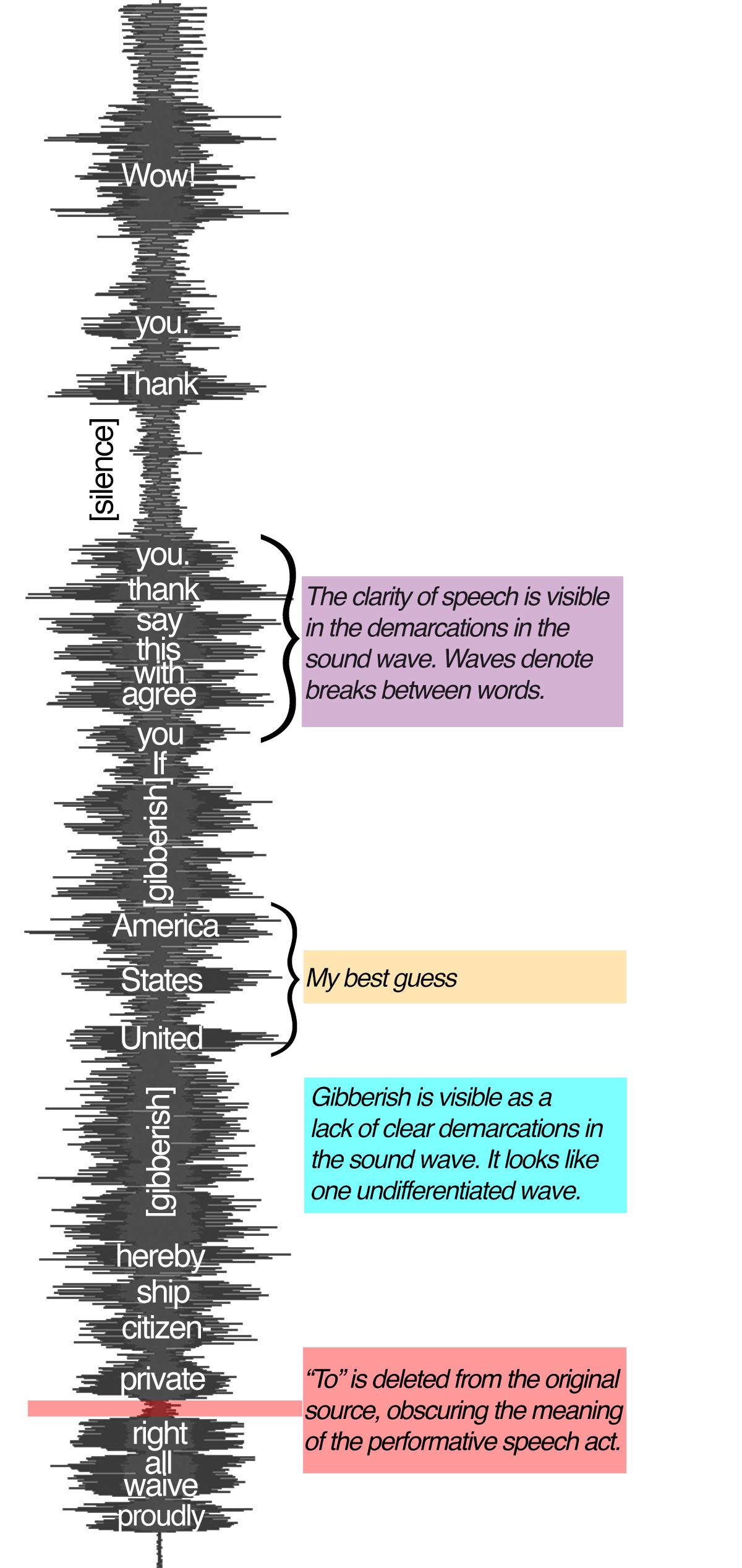
Source: Arrested Development, “Forget Me Now,” 2005. Sound wave created with Audacity and marked up in Adobe After Effects.
Buster is reenlisted in the Army on Arrested Development (TV)
The TV captioner, unlike the DVD captioner, plays god, jumping ahead into the future, grabbing the verbatim speech from the second clip, and dropping it into the first clip. As a result, the joke is ruined, a joke that depends on keeping the truth from everyone, viewers and characters alike, for nearly the entire episode. We aren’t supposed to know, initially. The producers went to lengths to create uncertainty by technically overriding the performative speech act with gibberish and contextually having Buster’s mother express her confusion. The TV captioner replaces nonsense sounds with verbatim speech – indeed, the captioner inserts the very words that comprise the performative speech act and are intentionally hidden from viewers (“hereby reenlist in the armed services”). Caption viewers are now armed with knowledge that non-caption viewers do not have and aren’t supposed to have. Put simply, the TV captioner mistakenly captions speech sounds that don’t exist.
Source: Arrested Development, “Forget Me Now,” 2005. IFC channel.
Source: Arrested Development, “Forget Me Now,” 2005. IFC channel.
Inaccessible acronyms to indicate sound effects and voiceover narration
Source: Television commercial for GEICO Insurance featuring SFX to indicate sound effects.
Source: Television commercials for Subaru and One A Day featuring VO and AVO speaker identifiers.
Music lyrics in the prom scene at the end of Twilight
Source: Twilight, 2008. DVD and iMovie.
Music captions in the opening scene of The Lost World: Jurassic Park
Source: The Lost World: Jurassic Park, 1997. AMC Network. Featured caption: [MUSIC].

